
Concept explainers
(a)
Interpretation:
IUPAC name for the carboxylic acid has to be given.
Concept Introduction:
For naming a carboxylic acid in
IUPAC rules for naming a carboxylic acid:
- The longest parent carbon chain is identified that includes the carboxyl group.
- The parent chain name is changed by replacing the suffix “-e” with “-oic acid”.
- Numbering is done in a way that the carboxyl group is designated as number 1. This is not indicated in the part of the name because for
aldehyde , the carboxyl carbon is always numbered 1. - The identity and location of substituents if any has to be determined and this information has to be added in front of the IUPAC name.
- If the carboxyl functional group is attached to a ring of carbon atoms, the ring is named and “-carboxylic acid” is added as suffix.
In a line-angle structural formula the point at which two lines intersect and the end points are carbon atoms.
(a)
Answer to Problem 16.16EP
IUPAC name of the given carboxylic acid is 4-methylpentanoic acid.
Explanation of Solution
Given structure of carboxylic acid is,

The longest continuous carbon chain has to be found out with the carboxyl group in it. In this it is a five carbon chain. Hence, the parent alkane is pentane. The carboxylic acid is named by replacing the suffix “-e” in the alkane name with “-oic acid”. This gives the name of carboxylic acid as pentanoic acid.
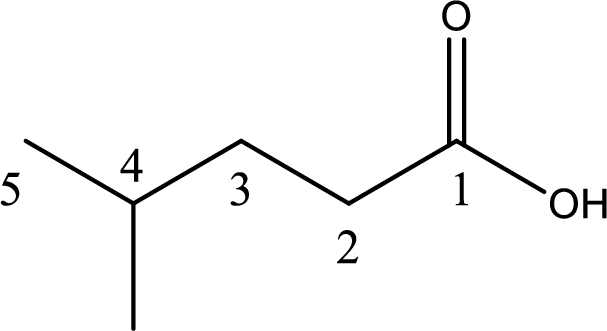
Looking for substituents it is found that there is a methyl group present on fourth carbon atom. Hence, the IUPAC name of the given carboxylic acid is 4-methylpentanoic acid.
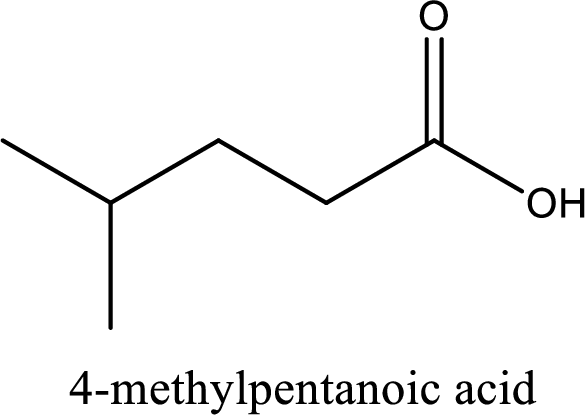
The IUPAC name of the given carboxylic acid is 4-methylpentanoic acid.
IUPAC name of the given carboxylic acid is found out.
(b)
Interpretation:
IUPAC name for the carboxylic acid has to be given.
Concept Introduction:
For naming a carboxylic acid in IUPAC nomenclature, the suffix “-oic” is added to the parent alkane name.
IUPAC rules for naming a carboxylic acid:
- The longest parent carbon chain is identified that includes the carboxyl group.
- The parent chain name is changed by replacing the suffix “-e” with “-oic acid”.
- Numbering is done in a way that the carboxyl group is designated as number 1. This is not indicated in the part of the name because for carboxylic acid, the carboxyl carbon is always numbered 1.
- The identity and location of substituents if any has to be determined and this information has to be added in front of the IUPAC name.
- If the carboxyl functional group is attached to a ring of carbon atoms, the ring is named and “-carboxylic acid” is added as suffix.
In a line-angle structural formula the point at which two lines intersect and the end points are carbon atoms.
(b)
Answer to Problem 16.16EP
IUPAC name of the given carboxylic acid is 2,4-dimethylpentanoic acid.
Explanation of Solution
Given structure of carboxylic acid is,

The longest continuous carbon chain has to be found out with the carboxyl group in it. In this it is a five carbon chain. Hence, the parent alkane is pentane. The carboxylic acid is named by replacing the suffix “-e” in the alkane name with “-oic acid”. This gives the name of carboxylic acid as pentanoic acid.
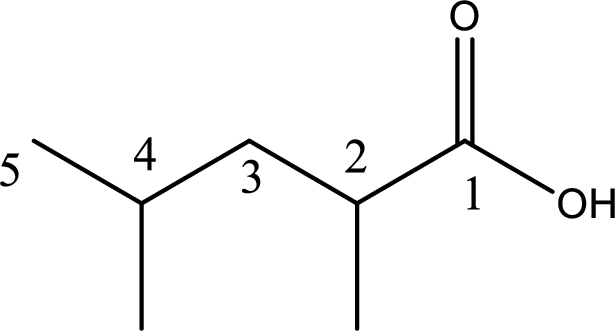
Looking for substituents it is found that there are two methyl groups present, each on second and fourth carbon atom. In the IUPAC name prefix “-di” has to be added before the alkyl name. Hence, the IUPAC name of the given carboxylic acid is 2,4-dimethylpentanoic acid.
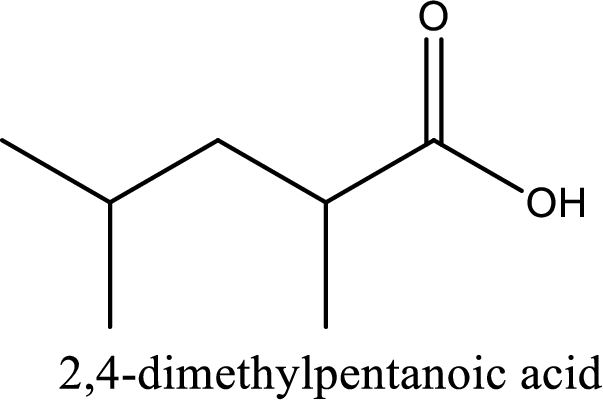
The IUPAC name of the given carboxylic acid is 2,4-dimethylpentanoic acid.
IUPAC name of the given carboxylic acid is found out.
(c)
Interpretation:
IUPAC name for the carboxylic acid has to be given.
Concept Introduction:
For naming a carboxylic acid in IUPAC nomenclature, the suffix “-oic” is added to the parent alkane name.
IUPAC rules for naming a carboxylic acid:
- The longest parent carbon chain is identified that includes the carboxyl group.
- The parent chain name is changed by replacing the suffix “-e” with “-oic acid”.
- Numbering is done in a way that the carboxyl group is designated as number 1. This is not indicated in the part of the name because for aldehyde, the carboxyl carbon is always numbered 1.
- The identity and location of substituents if any has to be determined and this information has to be added in front of the IUPAC name.
- If the carboxyl functional group is attached to a ring of carbon atoms, the ring is named and “-carboxylic acid” is added as suffix.
In a line-angle structural formula the point at which two lines intersect and the end points are carbon atoms.
(c)
Answer to Problem 16.16EP
IUPAC name of the given carboxylic acid is heptanoic acid.
Explanation of Solution
Given structure of carboxylic acid is,
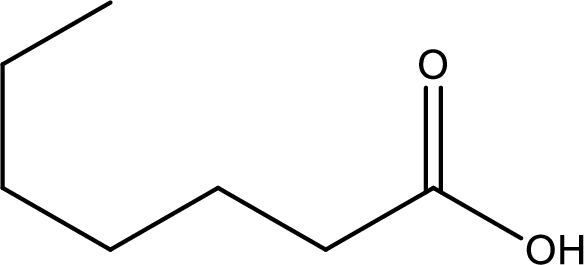
The longest continuous carbon chain has to be found out with the carboxyl group in it. In this it is a seven carbon chain. Hence, the parent alkane is heptane. The carboxylic acid is named by replacing the suffix “-e” in the alkane name with “-oic acid”. This gives the name of carboxylic acid as heptanoic acid.

Looking for substituents it is found that there are no substituents present on the carbon chain. Hence, the IUPAC name of the given carboxylic acid is heptanoic acid.
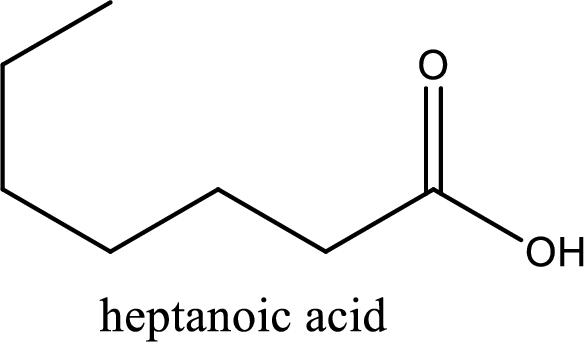
The IUPAC name of the given carboxylic acid is heptanoic acid.
IUPAC name of the given carboxylic acid is found out.
(d)
Interpretation:
IUPAC name for the carboxylic acid has to be given.
Concept Introduction:
For naming a carboxylic acid in IUPAC nomenclature, the suffix “-oic” is added to the parent alkane name.
IUPAC rules for naming a carboxylic acid:
- The longest parent carbon chain is identified that includes the carboxyl group.
- The parent chain name is changed by replacing the suffix “-e” with “-oic acid”.
- Numbering is done in a way that the carboxyl group is designated as number 1. This is not indicated in the part of the name because for aldehyde, the carboxyl carbon is always numbered 1.
- The identity and location of substituents if any has to be determined and this information has to be added in front of the IUPAC name.
- If the carboxyl functional group is attached to a ring of carbon atoms, the ring is named and “-carboxylic acid” is added as suffix.
In a line-angle structural formula the point at which two lines intersect and the end points are carbon atoms.
(d)
Answer to Problem 16.16EP
IUPAC name of the given carboxylic acid is 3,5-dimethylheptanoic acid.
Explanation of Solution
Given structure of carboxylic acid is,

The longest continuous carbon chain has to be found out with the carboxyl group in it. In this it is a seven carbon chain. Hence, the parent alkane is heptane. The carboxylic acid is named by replacing the suffix “-e” in the alkane name with “-oic acid”. This gives the name of carboxylic acid as heptanoic acid.

Looking for substituents it is found that there are two methyl groups present as substituents, each on third carbon atom and fifth carbon atom. Hence, the IUPAC name of the given carboxylic acid is 3,5-dimethylheptanoic acid.

The IUPAC name of the given carboxylic acid is 3,5-dimethylheptanoic acid.
IUPAC name of the given carboxylic acid is found out.
Want to see more full solutions like this?
Chapter 16 Solutions
EBK GENERAL, ORGANIC, AND BIOLOGICAL CH
- draw a fischer projection formula for the enantiomer of each of the following monosaccharides.arrow_forwardDraw the structure of a triacylglycerol whose components are glycerol and three oleic acid acyl groups.arrow_forwardDefine the following terms: a. reducing sugar b. alditol c. enediol d. acetal e. ketalarrow_forward
 Human Anatomy & Physiology (11th Edition)BiologyISBN:9780134580999Author:Elaine N. Marieb, Katja N. HoehnPublisher:PEARSON
Human Anatomy & Physiology (11th Edition)BiologyISBN:9780134580999Author:Elaine N. Marieb, Katja N. HoehnPublisher:PEARSON Biology 2eBiologyISBN:9781947172517Author:Matthew Douglas, Jung Choi, Mary Ann ClarkPublisher:OpenStax
Biology 2eBiologyISBN:9781947172517Author:Matthew Douglas, Jung Choi, Mary Ann ClarkPublisher:OpenStax Anatomy & PhysiologyBiologyISBN:9781259398629Author:McKinley, Michael P., O'loughlin, Valerie Dean, Bidle, Theresa StouterPublisher:Mcgraw Hill Education,
Anatomy & PhysiologyBiologyISBN:9781259398629Author:McKinley, Michael P., O'loughlin, Valerie Dean, Bidle, Theresa StouterPublisher:Mcgraw Hill Education, Molecular Biology of the Cell (Sixth Edition)BiologyISBN:9780815344322Author:Bruce Alberts, Alexander D. Johnson, Julian Lewis, David Morgan, Martin Raff, Keith Roberts, Peter WalterPublisher:W. W. Norton & Company
Molecular Biology of the Cell (Sixth Edition)BiologyISBN:9780815344322Author:Bruce Alberts, Alexander D. Johnson, Julian Lewis, David Morgan, Martin Raff, Keith Roberts, Peter WalterPublisher:W. W. Norton & Company Laboratory Manual For Human Anatomy & PhysiologyBiologyISBN:9781260159363Author:Martin, Terry R., Prentice-craver, CynthiaPublisher:McGraw-Hill Publishing Co.
Laboratory Manual For Human Anatomy & PhysiologyBiologyISBN:9781260159363Author:Martin, Terry R., Prentice-craver, CynthiaPublisher:McGraw-Hill Publishing Co. Inquiry Into Life (16th Edition)BiologyISBN:9781260231700Author:Sylvia S. Mader, Michael WindelspechtPublisher:McGraw Hill Education
Inquiry Into Life (16th Edition)BiologyISBN:9781260231700Author:Sylvia S. Mader, Michael WindelspechtPublisher:McGraw Hill Education





